Discovery
SECRET UNDERGROUND CITY IN MALI ZVORNIK
Stone Girl below the Mountain
Intended for longer stay of high government officials in difficult war conditions, it was built in strictest secrecy. So strict that even Germans, during four years of occupation, did not discover it. It stretches over 5,000 square meters, has a kilometer and a half of hallways, conditions for the placement of more than 3,000 people. Among seventy five rooms there are apartments for the king and his family, members of the government and the General Staff, dormitory for the guard, chapel, library, cantina, bathrooms, well, horse stalls... It was used in accordance with its purpose only for three days in April 1941. Today, eighty years later, someone finally had an idea to do something smart with it
Text and photographs: Nenad Marković
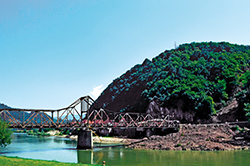 The last time that a foot of a Serbian, Yugoslav king walked around Serbia was in the spring of 1941, on the banks of the Drina in Mali Zvornik. While Wehrmacht units around the country were easily breaking the resistance of Yugoslav Royal Army, on April 12, young king Petar II Karađorđević crossed over to Bosnia, over the bridge the construction of which had been helped by his father Aleksandar I (after whim the bridge was named). From there, Petar II went to Nikšić and further into exile, from where he never returned. Three days before that, the king spent in the secret underground city created in the guts of the mountain of Boranje.
The last time that a foot of a Serbian, Yugoslav king walked around Serbia was in the spring of 1941, on the banks of the Drina in Mali Zvornik. While Wehrmacht units around the country were easily breaking the resistance of Yugoslav Royal Army, on April 12, young king Petar II Karađorđević crossed over to Bosnia, over the bridge the construction of which had been helped by his father Aleksandar I (after whim the bridge was named). From there, Petar II went to Nikšić and further into exile, from where he never returned. Three days before that, the king spent in the secret underground city created in the guts of the mountain of Boranje.
Military strategists of the Kingdom of Yugoslavia thought that, in case of war, geographical center of the country would be the perfect place for the placement of the general staff, and that is exactly the area around Mali Zvornik. Searching for an appropriate location, they determined that the hollow rocks in the slopes of Boranje had everything that was necessary to take over that role. Works on the construction of a war shelter, built under the code ”Stone Girl”, began in 1932, and were finalized, before actual completion, in the fall of 1934, after the killing of King Aleksandar in Marseille. One third of the structure remained unfinished.
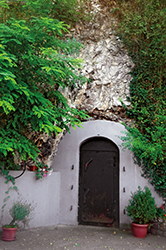 The structure occupies a surface area of about 5,000 square meters, it has hallways in total length of about a kilometer and a half, and 75 rooms. In the underground city there was room for more than 3,000 people, the king, his entourage, government and guards. The depth of the mountain was hiding the apartments intended for the placement of the king, his family, members of the government and military leadership, but also dormitory for the guard, chapel, library, canteen, horse stalls and other purpose rooms. On the very end of the unfinished structure, there is a well with fresh drinking water, covered with a concrete lid. It was supposed to ensure that the tenants of the city are not thirsty when the massive metal door gets closed, hiding them from the world. According to unsubstantiated stories, the main architect was a Russian, expert for mine excavation, and that the works were conducted by prisoners who were transported there during the night. They didn’t even know where they were, or what they were making. According to stories, only five people knew about this city, i.e. about its purpose: the king, prime minister, ministers of finance and defense, and the Chief of Staff.
The structure occupies a surface area of about 5,000 square meters, it has hallways in total length of about a kilometer and a half, and 75 rooms. In the underground city there was room for more than 3,000 people, the king, his entourage, government and guards. The depth of the mountain was hiding the apartments intended for the placement of the king, his family, members of the government and military leadership, but also dormitory for the guard, chapel, library, canteen, horse stalls and other purpose rooms. On the very end of the unfinished structure, there is a well with fresh drinking water, covered with a concrete lid. It was supposed to ensure that the tenants of the city are not thirsty when the massive metal door gets closed, hiding them from the world. According to unsubstantiated stories, the main architect was a Russian, expert for mine excavation, and that the works were conducted by prisoners who were transported there during the night. They didn’t even know where they were, or what they were making. According to stories, only five people knew about this city, i.e. about its purpose: the king, prime minister, ministers of finance and defense, and the Chief of Staff.
KING’S LAST DAYS IN SERBIA
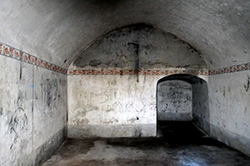 The city had twelve entrances closed by massive doors. A few of them are still visible today from the major road that stretches between the mountain and the river. Temperature inside is stable, between 14 and 16 degrees, and is not influenced by the seasons and external weather conditions. At the end of every right hallway, a small beam of light passes through ventilation openings. Along the concrete vaults, just like in unfinished rooms with bare rock, cave jewelry has begun to be created on the ceilings. These, still small and thin stalactites complement the beauty and mysticism of the structure.
The city had twelve entrances closed by massive doors. A few of them are still visible today from the major road that stretches between the mountain and the river. Temperature inside is stable, between 14 and 16 degrees, and is not influenced by the seasons and external weather conditions. At the end of every right hallway, a small beam of light passes through ventilation openings. Along the concrete vaults, just like in unfinished rooms with bare rock, cave jewelry has begun to be created on the ceilings. These, still small and thin stalactites complement the beauty and mysticism of the structure.
Along the hallway there are still fans that served for ventilation of the city, and are now rusted. One of the last sessions of the royal government took place in the biggest room, and not far from it there are apartments in which the young king spent his last nights in Serbia. The chapel is especially interesting. Painted in white, just like other rooms, it is the only one that had painted ornaments toward the top, and on the eastern wall there is a niche for the altar.
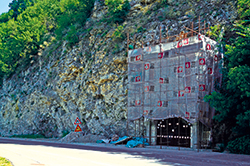 There is no reliable data on the origin of the ”Stone Girl”. The underground city was kept as the biggest secret and documents on its construction, if there were any, have not been found. Historical facts about the king’s stay there during the April War are known, and not much else. Elderly people from Mali Zvornik used to say that the Germans during the occupation did not find out about the existence of the secret city and never stepped into it. After the war, the city was of no interest to anyone. At first, it was used for the storing of medications of a pharmaceutical company, then for warehousing of beverages. Then it was forgotten.
There is no reliable data on the origin of the ”Stone Girl”. The underground city was kept as the biggest secret and documents on its construction, if there were any, have not been found. Historical facts about the king’s stay there during the April War are known, and not much else. Elderly people from Mali Zvornik used to say that the Germans during the occupation did not find out about the existence of the secret city and never stepped into it. After the war, the city was of no interest to anyone. At first, it was used for the storing of medications of a pharmaceutical company, then for warehousing of beverages. Then it was forgotten.
Not far from the iron Bridge of King Aleksandar, there is one of many entrances into the city, and a little farther away a church in the rock. Together with the chapel in the guts of the ”Stone Girl”, it was another place for prayer of the underground city. The church itself is not connected with the city and entrance into it is from the major road Loznica–Ljubovija. It was neglected for a long time, and when the times changed, it was brought back to life. After cleaning and restoring the interior, it was determined that it had been built in the shape of a cross with 33 meters long arms, which symbolizes the age of Christ. Interestingly, its construction began in 1933. Near the entrance into the church, water springs from the rock. They say that young Petar used to wash his face on this spring, near the guardsmen, every morning during his short stay there. At the entrance into this temple in the cave, there are currently works in progress, after which it will look like a smaller Church of the Holy Cross in Ostrog. A bell tower with a cross dedicated to those killed on the Drina is planned to be mounted on the rock above the door.
BUNKERS ON BANJA KOVILJAČA
These are not the only underground structures of the Karađorđević dynasty in the Drina River basin. In Banja Kovilјača, near Loznica, in the guts of the mountain of Gučevo, there are seven bunkers that were intended for placement of the Joint Chiefs of Staff. There was a plan, the story goes, to cut out the road through the mountain, which would connect the two shelters. The bunkers in Banja are located along the road above villas ”Dalmacija” and ”Herzegovina”, from which the concrete bridges lead right to two entrances in the guts of the mountain. In this way, in case of danger, it was possible to quickly find safe shelter. The slope was covered with thick pine forest, and the shelters made of thick reinforced concrete could not be seen from the air.
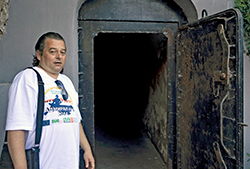 These bunkers are even more mysterious, because it is not known when exactly they were built. According to some accounts of elderly local people, the construction began at the time of completion of the iron bridge in Mali Zvornik, in 1929, while others claim that they were built between 1938 and 1940. It is known, however, that General Dušan Simović, prime minister and the Chief of Staff, arrived in Kovilјača on the first day of the April War, and that the decree of King Petar I about the attack on the country was issued here. From here, the general staff withdrew before the invading enemy toward the underground city in Mali Zvornik and from there into exile.
These bunkers are even more mysterious, because it is not known when exactly they were built. According to some accounts of elderly local people, the construction began at the time of completion of the iron bridge in Mali Zvornik, in 1929, while others claim that they were built between 1938 and 1940. It is known, however, that General Dušan Simović, prime minister and the Chief of Staff, arrived in Kovilјača on the first day of the April War, and that the decree of King Petar I about the attack on the country was issued here. From here, the general staff withdrew before the invading enemy toward the underground city in Mali Zvornik and from there into exile.
These bunkers of Banja are today in a poor condition and it is unknown what they are hiding in the depths. If enough funds were invested in their exploration and development, they could become an important tourist curiosity.
On the other hand, the ”Stone Girl” has already revealed herself to tourists and has occasionally received visitors in the past three years. Vojislav Stamenković, director of the Tourist Organization of Mali Zvornik, says that it took two years only to register the underground city as a property of the municipality and to hand it over to it for management. Its reconstruction is no finally possible and the works have already begun. According to Stamenković, the idea is to develop one third of the ”Stone Girl” as a contemporary museum exhibition, and to lease out the rest for certain appropriate purposes, which would secure funds for maintenance and further development of the city. One of the ideas is to organize weddings in the underground chapel , and to develop apartments for overnight stays. Certain scenes of TV series Ravna gora by Radoš Bajić were shot in the underground city of the Karađorđević dynasty and this, according to Stamenković, helped in determining what certain things looked like at that time. When the city is developed, everything will be furnished in the same way as it was at the beginning of the war.
Eight decades after construction had been suspended, the secret underground city of king Aleksandar, who was used for its purpose only for three days, could be given a new life and become an important place in the tourist map of Serbia.
***
Treasure, Holes and Bats
In certain rooms of the underground city in Mali Zvornik, next to the walls there are holes in the floor that were, it is thought, dug out by the communist OZN-a, after the war, in search for the king’s treasure. Hollows in the rock are visible in the part that the builders did not have time to fill with concrete and so make rooms. Until the recent weather conditions, the city was inhabited by numerous colonies of bats.
***
King’s Bridge
Vožd Karađorđe, according to the account, swore to bridge the Drina, and his vow was fulfilled by his great-grandson, King Aleksandar I. The solution for the iron bridge in Zvornik was adopted in 1926, the works began in 1927, and the river was bridged in 1929. The bridge, about 150 meters long and about seven meters wide, was formally opened on January 12, 1930, and carried the name of the king. Its strength was tested for half a month with 30,000 tons of transported rocks. It was demolished on April 14, 1941, in order to slow down the advancement of the enemy. It was restored in 1946, and was named ”Filip Klјajić Fića”, after a partisan war hero, and its original name was restored early this century. This iron old man is today in poor condition and is used only as a pedestrian bridge, the shortest connection between two namesake cities.
